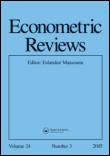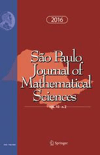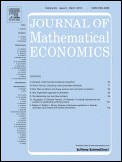
Ekonomika i Matematiceskie Metody-Economics and Mathematical Methods
Scope & Guideline
Unveiling the Synergy of Economics and Mathematical Methods
Introduction
Aims and Scopes
- Economic Modeling and Analysis:
The journal emphasizes the development and application of mathematical models to analyze economic systems, including agent-based models, dynamic models, and optimization techniques. - Statistical and Econometric Methods:
There is a strong focus on employing statistical analysis and econometric methods to derive insights from data, assess relationships, and forecast economic indicators. - Interdisciplinary Approaches:
The journal encourages interdisciplinary research that combines economics with fields such as sociology, environmental science, and information technology, reflecting the complexity of modern economic challenges. - Policy Implications and Practical Applications:
Research published often seeks to inform policy decisions and practical applications in various sectors, particularly in the context of the Russian economy and its regional specifics. - Innovation in Economic Theory:
The journal explores innovative theoretical frameworks and concepts, such as mesoeconomics and network economies, that challenge traditional economic paradigms.
Trending and Emerging
- Agent-Based Modeling:
There is a rising trend in the use of agent-based modeling to simulate complex interactions within economic systems, allowing for a more nuanced understanding of agent behavior and economic dynamics. - Sustainability and Renewable Energy Economics:
Recent papers show an increasing focus on the economic implications of transitioning to renewable energy sources, emphasizing the relevance of sustainability in economic modeling and policy. - Big Data and Predictive Analytics:
The integration of big data techniques and predictive analytics is becoming more prominent, reflecting a broader trend in economics towards data-driven research methodologies. - Economic Impacts of Global Events:
Research addressing the economic impacts of global events, such as the COVID-19 pandemic, has gained traction, emphasizing the need for adaptive economic models that account for sudden shifts in the economic landscape. - Socio-Economic Interactions:
Emerging themes that explore the interactions between economic factors and social behaviors are becoming more prevalent, indicating a growing interest in the socio-economic dimensions of economic modeling.
Declining or Waning
- Traditional Economic Theories:
There has been a noticeable decrease in papers focused solely on classical economic theories, as the journal shifts towards more applied and innovative methodologies. - Static Economic Models:
The use of static models, which do not account for dynamic interactions or time-dependent factors, appears to be waning in favor of dynamic and agent-based modeling approaches. - Single-Dimensional Analysis:
Research that employs single-dimensional analysis of economic factors without considering broader interactions and complexities has become less common, indicating a trend towards more holistic approaches. - Descriptive Studies:
There is a decline in purely descriptive studies that lack quantitative analysis, as the journal increasingly favors research that employs rigorous mathematical or statistical techniques.
Similar Journals

Econometric Reviews
Pioneering Research at the Intersection of Economics and DataEconometric Reviews, published by Taylor & Francis Inc, is a premier journal in the field of Economics and Econometrics, recognized for its significant contributions to the advancement of economic theory and practice since its inception. With its ISSN 0747-4938 and E-ISSN 1532-4168, the journal has maintained a consistent publication record from 1982 to 2024, offering a platform for groundbreaking research that shapes the landscape of quantitative economic analysis. With a proud place in the Q1 category for Economics and Econometrics as of 2023, it stands as a critical resource for scholars, practitioners, and students alike, actively engaging with themes such as econometric methods, theory, and policy implications. Although operating under a subscription model, the journal’s high impact factor reflects its esteem within the academic community, fostering a rich dialogue among researchers in this evolving discipline. The journal’s office is located at 530 Walnut Street, Ste 850, Philadelphia, PA 19106, USA, forging connections in one of the central hubs of economic research.

Applied and Computational Mathematics
Innovating Solutions Through Applied and Computational ResearchApplied and Computational Mathematics is a premier journal dedicated to the dissemination of innovative research in the fields of applied mathematics and computational mathematics. Published by the MINISTRY COMMUNICATIONS & HIGH TECHNOLOGIES REPUBLIC AZERBAIJAN, this journal offers a prominent platform for scholars and practitioners worldwide, boasting an impressive Q1 category ranking in applied mathematics and Q2 in computational mathematics for 2023. With an excellent Scopus ranking placing it in the 96th percentile for both categories, it highlights the high quality and global impact of its published work. The journal spans a wide range of topics, ensuring it remains relevant to current and emerging trends in both theoretical and applied contexts. Access to its articles is streamlined through open channels, promoting collaboration and knowledge sharing among researchers. Applied and Computational Mathematics is pivotal for advancing the discipline and supporting the academic community's growth, making it an essential resource for researchers, professionals, and students alike.

Mathematics and Financial Economics
Exploring the Nexus of Numbers and MarketsMathematics and Financial Economics, published by Springer Heidelberg, is a leading peer-reviewed journal that explores the intersections of mathematical theories and financial practices. With an ISSN of 1862-9679 and an E-ISSN of 1862-9660, the journal has made notable contributions to its field since its inception in 2007, with a convergence period extending until 2024. Positioned in the prestigious Q2 category for both Finance and Statistics and Probability, the journal is ranked within the top 66th percentile in Mathematics and Statistics and the 62nd percentile in Decision Sciences according to Scopus metrics. Researchers and professionals looking for high-quality, innovative research in mathematical finance will find valuable insights within its pages. Although primarily a subscription-based journal, it aims to foster knowledge sharing among academia and industry experts. Its commitment to advancing quantitative methods and financial applications solidifies its importance as a resource for students, researchers, and practitioners dedicated to understanding and navigating the complex dynamics of financial markets.

Sao Paulo Journal of Mathematical Sciences
Empowering researchers to share transformative mathematical insights.Welcome to the Sao Paulo Journal of Mathematical Sciences, a pivotal platform dedicated to advancing the field of mathematics, published by Springer International Publishing AG. Established in 2015 and running until 2024, this journal serves as a vital resource for researchers, professionals, and students interested in a plethora of mathematical topics, including computational theory, statistics, and general mathematics. While the journal holds a current Q4 quartile ranking in its categories, it provides an opportunity for contributors to disseminate innovative findings in an accessible manner. Although not an open-access publication, the journal is committed to ensuring that high-quality research is available to the academic community, fostering collaboration and growth within the discipline. Researchers seeking to publish in a dynamic and developing journal should consider the Sao Paulo Journal of Mathematical Sciences as an essential avenue for their work.

JOURNAL OF MATHEMATICAL ECONOMICS
Fostering Interdisciplinary Dialogue in Economics and Mathematics.JOURNAL OF MATHEMATICAL ECONOMICS, published by Elsevier Science SA, is a premier journal that bridges the gap between mathematics and economics, making significant contributions to both fields since its inception in 1974. This journal is dedicated to publishing high-quality research that applies mathematical methods to solve complex economic problems, thus nurturing an interdisciplinary dialogue essential for advancing both theoretical and practical applications in economics. With an impact factor that reflects its esteemed position (Q2 in Applied Mathematics and Economics and Econometrics as of 2023), the journal ranks prominently within its categories, promoting rigorous analysis and innovative methodologies. The Journal of Mathematical Economics invites contributions from researchers, professionals, and students alike, providing a platform for the dissemination of cutting-edge research that shapes economic thought and policy. Operating without open access, it remains a crucial resource for anyone keen to delve deeper into the mathematical foundations of economic theory, while it continues to evolve and maintain relevance through 2024 and beyond.

Matematika
Exploring the Depths of Mathematical KnowledgeMatematika, an esteemed journal published by PENERBIT UTM PRESS, serves as a pivotal platform for showcasing innovative research in the field of mathematics. With the ISSN 0127-8274, this publication is dedicated to advancing mathematical knowledge and its applications, making significant contributions to both theoretical and applied mathematics. Although currently not offering open access, the journal is recognized for its rigorous peer-review process, ensuring the quality and integrity of published works. With its base in Skudai, Johor, Malaysia, Matematika plays a crucial role in promoting mathematical literacy and research within the ASEAN region and beyond. It invites researchers, professionals, and students to explore and contribute to the vibrant discussions that shape the future of mathematics.

European Journal of Mathematics
Exploring the Depths of Mathematical KnowledgeWelcome to the European Journal of Mathematics, a prominent publication that serves as a vital platform for disseminating high-quality research in the field of mathematics. Published by Springer International Publishing AG, this journal has witnessed significant growth since its inception in 2015 and is recognized for its contributions within the Q2 category of Mathematics (miscellaneous) as per the 2023 rankings. With an ISSN of 2199-675X and an E-ISSN of 2199-6768, the journal aims to foster innovation and collaboration among researchers, professionals, and students alike. Although it operates under a traditional access model, the journal's commitment to advancing mathematical knowledge and applications cannot be overstated. Positioned among the top-tier publications, the European Journal of Mathematics is an essential resource that encourages the exploration of emerging trends and theories in mathematics, making it indispensable for anyone striving to stay at the forefront of this dynamic field.

ECONOMETRICA
Fostering intellectual discourse in econometrics.ECONOMETRICA, published by Wiley, is a leading journal in the field of economics and econometrics, renowned for its rigorous and cutting-edge research contributions. With an ISSN of 0012-9682 and an E-ISSN of 1468-0262, this esteemed journal holds a prestigious position in the academic landscape, classified in the top quartile (Q1) for both Economics and Econometrics as of 2023, and ranked 42 out of 716 in its field, placing it in the 94th percentile according to Scopus metrics. The journal's scope encompasses a diverse range of topics aimed at advancing economic theory and its practical applications, making it an essential resource for scholars, practitioners, and students alike. Although it operates under a subscription model, the depth and quality of research published in ECONOMETRICA underscore its significance as a cornerstone for intellectual discourse and innovation within the field. Based in the United Kingdom, at 111 River St, Hoboken, NJ 07030-5774, ECONOMETRICA continues to attract high-caliber contributions that shape the future of econometric research.

International Journal of Applied Mathematics & Statistics
Fostering Collaboration in Mathematical Research and ApplicationThe International Journal of Applied Mathematics & Statistics, published by the CENTRE ENVIRONMENT SOCIAL & ECONOMIC RESEARCH PUBL-CESER, is a vital platform for researchers and professionals dedicated to advancements in the field of applied mathematics and its statistical applications. With an ISSN of 0973-1377 and an E-ISSN of 0973-7545, this journal presents innovative research from 2003 to 2013, offering insights into various mathematical techniques and statistical methodologies fundamental for solving real-world problems. Although its coverage in Scopus has been discontinued, the journal remains relevant within its scholarly community, emphasizing the importance of collaborative research and interdisciplinary approaches for tackling complex societal challenges. Its commitment to promoting qualitative and quantitative research makes it an invaluable resource for students and professionals aiming to enrich their expertise and contribute to ongoing developments in applied mathematics and statistics.

Economic Computation and Economic Cybernetics Studies and Research
Shaping Tomorrow's Economics with Innovative Research.Economic Computation and Economic Cybernetics Studies and Research, published by EDITURA ASE in Romania, serves as a vital platform for the dissemination of innovative research in the fields of applied mathematics, economics, and computer science applications. Established in 1968, this journal spans several decades of academic scholarship, converging expertise and insights that are instrumental in shaping current economic theories and methodologies. With an HIndex reflecting the impact of its contributions, the journal has garnered a Q4 ranking in Applied Mathematics and Computer Science Applications, alongside a Q3 distinction in Economics and Econometrics as of 2023. Its commitment to fostering an open exchange of ideas is crucial for researchers, professionals, and students who are navigating the complexities of economic cybernetics and computational economics. Although it operates without open-access options, its robust accessibility ensures that the research published within reaches a broad audience, further enhancing its relevance and importance in today’s rapidly evolving economic landscape.